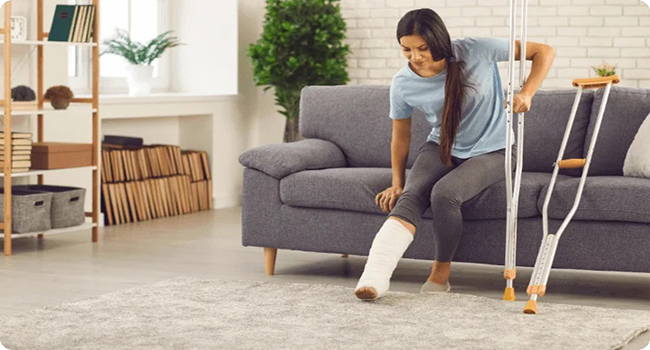Menu

Plastering and removing the plaster at home is a safe and easy method for people who have fractured at home or at work and cannot go to medical centers in person due to problems. Considering that bone fracture is a common event that can happen to any person for various reasons, such as a decrease in bone density due to aging, direct impact, falls, accidents, etc., timely action should be taken at any hour of the day. Without the slightest shock and tension, it is considered important and necessary for this group of people. In such a situation, and in the event of any injury or fracture, they should request a doctor or nurse for a broken ligament from a reputable home medical service center as soon as possible.
Shafagostar Shiraz home treatment center, with the permission of the Ministry of Health and its experienced specialists, provides the best and highest quality medical services at home in order to meet the treatment needs of patients at any hour of the day and night as soon as possible. Our experts have received specialized training in the field of plastering and plaster removal at home to provide the patient with maximum recovery and minimum rehabilitation needs after plastering and removal. Stay with us until the end of this article so that we can examine together the method and necessity of plastering and removing plaster at home by medical service centers.

Important and necessary measures before plastering
Always before the nurse or fracture specialist places the plaster band on your body and around the broken bone, they check your injuries to ensure the application of plastering and if they are sure of the necessity of surgery to adjust the bone. will be referred to an orthopedic surgeon. After lining up and adjusting the broken parts of the bone, he starts plastering as follows:
First, they place a layer of soft, stretchy fabric, such as a stocking, over your body around the broken bone, and the pantyhose applies gentle, steady pressure to the area to help it heal and prevent swelling. Then, cotton or another soft layer is stretched over the stocking, the material of these fabrics is such that they harden over time after being mixed and moistened with calcined plaster.
Plastering and its special molds
Since the bone has the ability to self-repair over time and with proper care, for this reason, in order to heal it and keep the injured arm or leg stable, a cast made of calcined plaster or fiberglass is used, which is closed Depending on age, general health and the type of fracture, it will remain on the injured part for about six weeks or more. In other words, plastering prevents the injured limb from moving and protects your body after an injury.
Fiberglass, the most common form of plaster
Fiberglass is a type of plastic and composite plaster, which is more common than calcined plaster due to its lightness and durability. This type of mold, which is made of composite resin and glass, is mostly used for plastering at home.
Important advantages of plastering at home with fiberglass
· Porous or airless: This type of feature in this type of mold allows air to pass through it, and hence plaster tolerance is tolerable for people.
· Color variety: If you need this type of template, you can choose a specific color if you wish.
· Having different widths: one of the good features of this template is that it is available in different widths and in strip form.
· Ability to pass X-rays: this type of mold, unlike plaster, can easily pass X-rays. During the time that there is plaster on the damaged area, X-ray photography is done to check the bone to control how it is repaired and the healing process. If a problem is detected in the type of fracture or how to heal it, instead of plastering and removing the plaster at home, they will refer you to an orthopedic surgeon.
· Fast drying: unlike calcined plaster, these types of molds dry and harden quickly within a few hours.
The easiest plaster mold
Plaster is easier and better to work with in that it molds more easily to the shape of your body, even around the bones, but fiberglass is more commonly used these days. If you have a displaced fracture (your broken bone protrudes from its usual place), you will need to use a cast. One of the advantages that plaster has over fiberglass is that plaster looks smooth and white when it hardens, while fiberglass will look rough when it dries.
Both fiberglass and plaster come in tape rolls. After moistening the tapes, the health care provider continues to wrap them around the fracture until the cast is complete. After using the plaster, it is recommended that you visit the doctor the next day so that the necessary examination on how to remove the plaster and open the plaster at home will be done.
How to open plaster at home and the need to do it by professionals
After completing the treatment process, specialists use a special saw to open plaster at home. The blade of this saw cuts plaster without damaging the skin. They cut the plaster in several places, usually along both sides, and then open and lift the plaster, and then use a pair of scissors to cut away the protective layers and stocking.
Due to the high sensitivity of the injured organ after the end of the treatment period, no pressure should be applied to it, it is better to apply plaster and open the plaster at home only from nurses in order to ensure the healing of the fracture. And ask our broken strap specialists for help so that this work can be done easily and without worries for you.